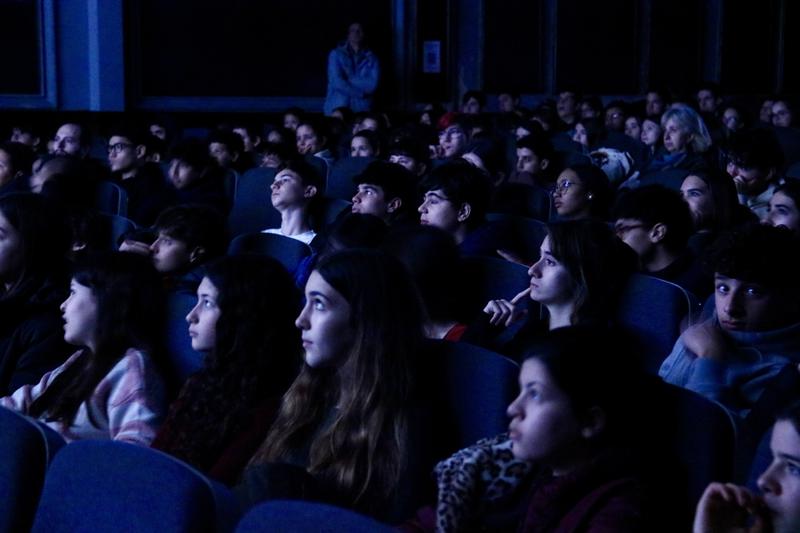Cinemas offer only 2.8% of sessions in Catalan language
Overwhelming majority of dubbings in Spanish, Catalan limited to non-prime time and kids' screenings

The Catalan language is almost non-existent cinemas across the country, according to data of all the screenings in Catalonia between 2017 and 2021 obtained and analyzed by the Catalan News Agency (ACN) from the Catalan government office ICEC.
Only 2.8% of the sessions that took place during that period were either original or dubbed versions in Catalan, while the vast majority were screenings of films dubbed to Spanish.
In a country where the clear norm is still dubbing the foreign-language films, rather than offering the original version with Spanish or Catalan subtitles, the proportion of Catalan dubbings is irrelevant, very far from the social use of the language across the territory.
Between 2017 and 2021, only 84,410 of the 2.9 million film showings were in Catalan, either dubbed (73% of the total number of sessions in this language) or original versions.
Discussion over the demand of Catalan in cinemas
Talking to ACN, the director of the Gremi d'Exhibidors cinemas association in Catalonia, Pilar Sierra, said they "try to offer the original, dubbed and subtitled Catalan versions in the best conditions, but taking into account the demand."
Yet, also talking to the same media outlet, cinema industry expert and professor at URL university Francesc Vilallonga said that the low demand is a "preconceived notion."
"Catalan versions should be treated better," he added, saying time distribution, the number of copies, what cinemas of what areas the versions are scheduled and promoting the offer should be improved in order to see how the audience reacts in an "equal opportunities" scenario.
Majority of Catalan sessions scheduled during non-peak hours
Also, those Catalan dubbed versions are mainly programmed in non-prime time: two out of three screenings (66.9%) were scheduled between 3pm and 7pm, while between 7pm and 1am the percentage drops to 22.7%.
This time distribution is quite different to that of the cinema consumption in the country on average. Overall 51% of the cinema-goers buy tickets for sessions that start from 7pm onwards, while 45% do so between 3pm and 7pm – while this is significantly different to Catalan sessions, showings in Spanish did enjoy a time distribution matching the demand.
One key reason to understand the anomaly is the fact that most international films are not dubbed to Catalan, and most of the ones that are available in this language are addressed to kids, who are more used to watching cinema in the afternoon rather than in the evening.
Indeed, out of the 30 biggest box-office earning movies between 2017 and 2021, only 10 had a Catalan version – and seven out of them were for children.
Sierra says that the higher number of dubbings for minors has a big impact on the time distribution.
While this is true, the bias limiting Catalan to lesser popular times is not only down to the genre. Considering the eight most popular films dubbed to Catalan and Spanish that are suitable for adults rather than kids, 50% of Catalan-language sessions were scheduled for the afternoon, and 41.5% for the evening, while 41.9% of Spanish versions were available in the afternoon and 52.1% for the evening.
The presence of Catalan in cinemas across the country is asymmetrical: while the average is 2.8%, the sessions in the metropolitan counties – below average in the social use of the language – oscillate between 2% and 2.7%. Elsewhere, in the county including the northeastern city of Girona, the percentage raises to 4.9%, and the one where western Lleida is located reaches 5.2%.
'Alcarràs', 'Barbie' and Indiana Jones help increase Catalan language spectators
The number of spectators for the Catalan sessions were 1.5 million out of the total 70.4 million in the same period (2.1%), according to ICEC figures. The figures analyzed end in 2021, the most recent consolidated data. Yet, the provisional figures from ComScore, a marketing company monitoring cultural consumption, show that the percentage is slightly raising.
According to ComScore, the figure for 2017 to 2021 was 1.6% but in 2022 it grew to 5.5% thanks to the success of 'Alcarràs', and in 2023 it stood at 2.9%.
Catalan government sources told ACN that the increase is partly due to their higher public spending in both Catalan language original productions (€20.7 million in 2023, four times more than in 2019) and in dubbings of international versions (€3.3 million in 2023). Thanks to this effort, films such as 'Barbie', 'The Super Mario Bros. Movie' and 'Indiana Jones and the Dial of Destiny' were also available in Catalan.
Àlex de la Guia, from desdelsofà.cat website, which has created a database of the cinema and series offer in Catalan, said to ACN that both 'Barbie' and the latest of the Indiana Jones saga are good examples of the fact that "if they are scheduled in good times, people consume them in Catalan."